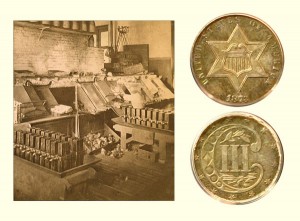oday, the Silver Trime Coin, a three-cent coin, remembers the people’s concern and the resulting explanation of silver coinage 142 years ago.
On October 30, 1873, the Meriden [CT] Daily Republican printed the following article:
=====
Silver Coin
How It Will Be Issued.
As there appears to be some misapprehension on the part of the public in relation to the purpose of the government in paying out silver coin, the following explanation has been made furnished by the director of the mint:
In this, as in other countries where gold is the sole standard or measure of value, silver coins are overvalued for the purpose of rendering them exportable.
They are manufactured and issued on the government account, the law, however, placing directly or indirectly a limit on the issue to prevent redundancy.
If issued in times of specie payment beyond the requirement of the public for change, such coin will not maintain its purchasing power with the standard coin.
Owing to various causes in this and other countries, silver has declined in value to a point at which the government can purchase it with gold, manufacture it into small coin and pay it out at a fair profit.
The government has recently purchased a quantity of silver bullion sufficient for its purpose at 112 1/2 cents per standard ounce, and will manufacture it into coin at the legal rate of 124 and four-tenth cents per ounce, the difference between purchasing and issuing being within a faction of twelve cents per ounce or about 10 1/2 percent on the gold coin paid in purchase.
This operation is believed to be a more profitable one for the treasury and also more advantageous to the public in the present condition of the money market than the sale of gold for legal tenders, and it is not a scheme for the resumption of specie payments, but simply compliance with the mint laws.
A dollar in United States currency will purchase more gold in the market than a dollar of small silver coins.
Dollars will therefore, soon find their level and unless there be a rise in both the prices of gold and silver, small coins must circulate concurrently with paper money.
The government has in possession of the assistant treasurer about $500,000 in silver coin, and at the mints and assay offices in silver bullion and coin about $2,000,000.
This stock is ample for the present.
This mode of paying out silver coin will be continued until circumstances shall dictate a contrary course as proper.
The government will exact the full seigniorage required by law, but will not undertake to control the disposition of the coin after it is paid out.
The coin will then become the property of the holders who may do what they please with it.
This course was not decided upon until it had been fully considered by the secretary of the treasury.
=====
The Silver Trime Coin shows beside the smelting room at the Philadelphia Mint, circa 1876.
